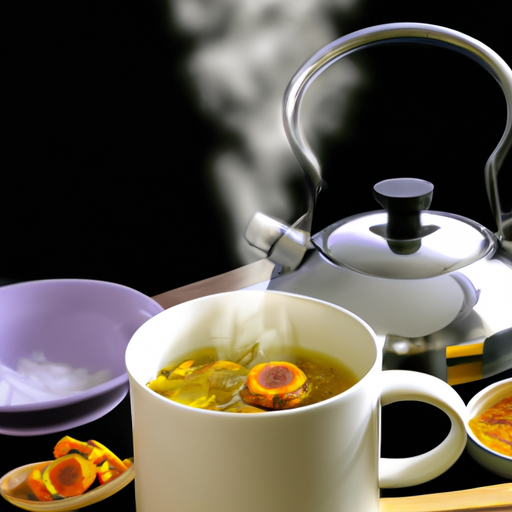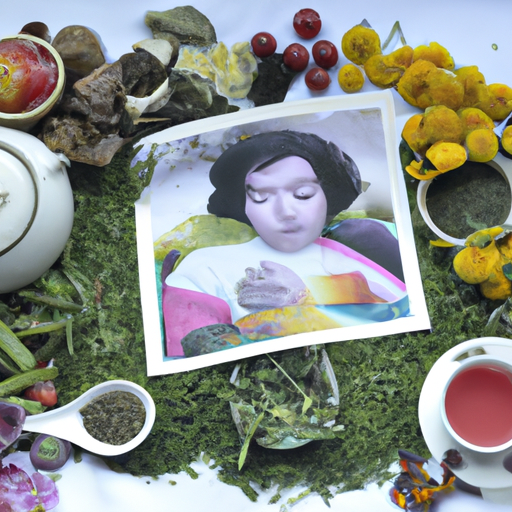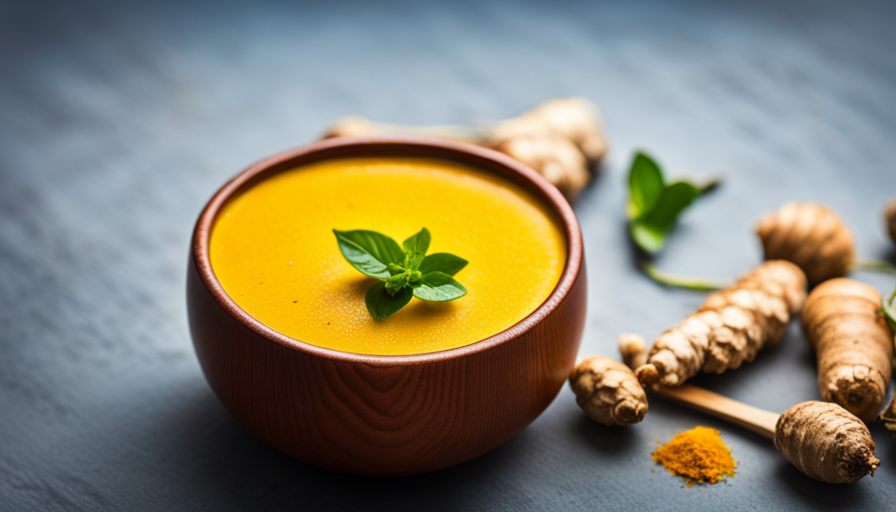Are you in search of a cozy and beneficial drink? Turmeric tea is the perfect choice for you!
This delicious drink is made from the root of the turmeric plant, which is popular in Indian and Southeast Asian cuisine. Turmeric contains a powerful anti-inflammatory compound called curcumin, which has been linked to a range of health benefits, including improved brain function, reduced risk of heart disease, and even potential cancer-fighting properties.
Making turmeric tea from scratch is easy and affordable, and allows you to customize the recipe to your liking. In this article, we’ll walk you through the steps of preparing and brewing your own turmeric tea, and offer tips and tricks for perfecting your recipe.
Whether you’re looking for a morning pick-me-up, a cozy evening drink, or a natural way to boost your health and wellness, turmeric tea is the perfect choice. So grab your ingredients and get ready to enjoy a delicious and nourishing cup of turmeric tea!
Key Takeaways
- Making turmeric tea from scratch is easy and affordable.
- Toast and grind spices for full flavor.
- Use high-quality ingredients, such as fresh turmeric root and filtered water, and steep the tea for at least 10 minutes to allow the flavors to fully develop.
- Adding a pinch of black pepper can enhance curcumin absorption.
Gather Your Ingredients
Before you begin, make sure you’ve gathered all the necessary ingredients for making this delicious turmeric tea. You’ll need turmeric, water, honey, and a pinch of black pepper.
Turmeric can be found at most grocery stores or health food stores, or you can purchase it online. For the best flavor and health benefits, make sure to get fresh turmeric root or ground turmeric powder.
Turmeric has been used for centuries in Ayurvedic medicine for its numerous health benefits, including its anti-inflammatory and antioxidant properties. It’s also believed to boost the immune system and improve brain function. Incorporating turmeric into your diet is an easy way to reap these benefits and enjoy a delicious beverage.
Now, let’s move on to preparing your spices.
Prepare Your Spices
First, you’ll want to gather your spices and get ready to spice things up in your cup! To begin preparing your spices, you’ll need to toast and grind them to bring out their full flavor. Toasting the spices involves heating them in a dry skillet over medium heat until they become fragrant and slightly browned. This process can take anywhere from 1-3 minutes depending on the type of spice you’re toasting, so be sure to keep a close eye on them and stir frequently to prevent burning.
Once your spices are toasted, it’s time to grind them into a fine powder. You can do this using a spice grinder, coffee grinder, or mortar and pestle. Grinding the spices will release their oils and intensify their flavor, so take your time and be thorough in your grinding. After your spices are ground, you can set them aside and move on to the next step of brewing your tea.
In the table below, you can see the difference in flavor between using pre-ground spices and freshly toasted and ground spices. Trust us, the extra effort is worth it!
| Pre-ground Spices | Toasted and Ground Spices | |
|---|---|---|
| Aroma | Mild | Strong and Fragrant |
| Flavor | Dull and Flat | Rich and Complex |
| Color | Pale | Vibrant and Golden |
Now that your spices are prepped and ready to go, it’s time to brew your tea.
Brew Your Tea
Now that you’ve toasted and ground your spices, it’s time to brew your tea!
Start by boiling 2 cups of water in a pot. Once the water is boiling, add 1 teaspoon of turmeric and 1 teaspoon of ginger to the pot. Reduce the heat to low and let the spices simmer for about 5 minutes.
Next, add 1 teaspoon of honey to the pot and stir well. Honey not only adds sweetness, but it also has antibacterial properties that can help soothe a sore throat. If you like your tea creamier, you can add a splash of milk or coconut milk.
Tea brewing techniques are important to get the perfect cup of tea that suits your taste buds. Experiment with different types of tea brewing techniques to find the one that works best for you.
Flavor pairings are also important to consider when brewing tea. Turmeric tea pairs well with cinnamon, black pepper, and lemon, so feel free to add these ingredients to your tea for an even more delicious flavor.
Now that you have brewed your tea, it’s time to strain and serve.
Strain and Serve
Once the spices have simmered for 5 minutes, it’s time to strain the tea and add any desired garnishes before serving.
Straining the tea is important to remove any bits of ginger or cinnamon that may have escaped the tea bag or mesh strainer. This will ensure that your turmeric tea is smooth and free of any unwanted bits.
When serving your turmeric tea, you might want to add a slice of lemon or a teaspoon of honey to enhance the flavor. Lemon will add a tangy taste and honey will add sweetness.
Additionally, straining the tea will also help to increase the intensity of the tea’s color. You can serve the tea hot or cold, depending on your preference.
Now that you’ve strained and served your turmeric tea, it’s time to customize your recipe to your liking.
Customize Your Recipe
Now that you know how to make turmeric tea from scratch, it’s time to customize your recipe to your liking.
Adjust the spice levels by adding more or less turmeric, ginger, or black pepper.
Experiment with different sweeteners like honey, maple syrup, or stevia to find the perfect balance of sweetness.
And don’t be afraid to add other flavors like cinnamon or cardamom for an extra kick.
Make your turmeric tea unique and delicious with these simple adjustments.
Adjusting Spice Levels
By adding a pinch more of turmeric, you can give your tea an extra kick of warmth and comfort. Spice balancing is a crucial aspect of making turmeric tea. It’s a matter of personal preference, so feel free to experiment with different spice levels until you find the perfect balance.
Start by adding small amounts of turmeric and gradually increase the quantity until you reach your desired level of spiciness. Be careful not to overdo it, as turmeric has a strong and slightly bitter taste that can quickly overpower the other flavors.
Flavor experimentation is also a fun and exciting part of making turmeric tea. You can add other spices, such as ginger, cinnamon, or cardamom, to enhance the flavor and aroma of your tea. Don’t be afraid to get creative and try new combinations until you find your perfect blend.
Once you have adjusted the spice levels to your liking, it’s time to move on to the next step of adding different sweeteners to your turmeric tea.
Adding Different Sweeteners
To enhance the flavor of your turmeric-infused beverage, you should consider adding different sweeteners that complement the spices and bring out its natural sweetness. When it comes to choosing the best sweetener for your turmeric tea, you have a variety of options to explore.
Some of the most popular sweeteners include honey, stevia, sugar, and coconut nectar. Honey and stevia are excellent natural sweeteners that add a touch of sweetness without overpowering the flavor of turmeric. Sugar and coconut nectar are also great options, but they may add more sweetness than necessary. Keep in mind that adding too much sweetener can mask the natural flavor of turmeric, so it’s best to start with a small amount and adjust as needed.
With the right sweetener, your turmeric tea will become a perfect balance of sweet and spicy. To perfect your turmeric tea, there are a few tips you should keep in mind. One of the most important things is to use high-quality ingredients, such as fresh turmeric root and filtered water. Additionally, you should steep the tea for at least 10 minutes to allow the flavors to fully develop.
With these tips, you’ll be able to enjoy a delicious, healthy cup of turmeric tea that you can savor any time of day.
Tips for Perfecting Your Turmeric Tea
If you want to take your turmeric tea to the next level, don’t hesitate to add a pinch of black pepper to enhance the absorption of curcumin. Curcumin is the active ingredient in turmeric that gives it its anti-inflammatory and antioxidant properties. However, the body can have a hard time absorbing curcumin on its own. That’s where black pepper comes in. It contains piperine, which has been shown to increase the absorption of curcumin by up to 2,000%.
In addition to adding black pepper, there are a few other tips for perfecting your turmeric tea. First, make sure you are using high-quality turmeric. There are different varieties of turmeric, so experiment with a few to find the one you like best. Second, be mindful of the amount of turmeric you use. Too much can make the tea bitter and overpowering. And finally, don’t be afraid to experiment with different flavors and ingredients, such as ginger, honey, or lemon, to find the perfect combination for you.
Now, let’s explore the health benefits of turmeric tea.
Health Benefits of Turmeric Tea
Now that you’ve learned some tips for perfecting your turmeric tea, let’s talk about the health benefits you can reap from regularly drinking it. Turmeric has been used for its medicinal properties for centuries, and turmeric tea is a delicious and easy way to incorporate it into your diet. One of the key benefits of turmeric tea is its anti-inflammatory properties. Curcumin, the active ingredient in turmeric, has been shown to reduce inflammation in the body, which can help with conditions such as arthritis and even improve brain function.
In addition to its anti-inflammatory properties, turmeric tea may also have cancer-preventing effects. Studies have shown that curcumin can help prevent the growth and spread of cancer cells, particularly in breast, colon, and prostate cancers. While further research is needed to fully understand the extent of these benefits, incorporating turmeric tea into your diet is a simple and tasty way to potentially improve your overall health.
| Health Benefits of Turmeric Tea | |
|---|---|
| Anti-inflammatory properties | Curcumin in turmeric can reduce inflammation in the body, which can help with conditions such as arthritis and even improve brain function. |
| Cancer prevention | Curcumin can help prevent the growth and spread of cancer cells, particularly in breast, colon, and prostate cancers. |
As with any new addition to your diet, it’s important to be aware of any potential side effects. In the next section, we’ll discuss some possible side effects of turmeric tea and how to mitigate them.
Potential Side Effects
Be aware of the potential side effects that may arise from drinking turmeric tea, such as stomach upset or allergic reactions, and take precautions to prevent them.
Turmeric tea can interact with certain medications, such as blood thinners, and may cause adverse reactions. It’s important to consult with a healthcare professional before consuming turmeric tea, especially if you’re on medication or have a pre-existing medical condition.
To prevent potential side effects, it’s important to consume turmeric tea in moderation and not exceed the recommended dosage. It’s also important to ensure that the turmeric used to make the tea is of high quality and free from contaminants.
If you’re pregnant or breastfeeding, it’s best to avoid turmeric tea or consult with a healthcare professional before consuming it, as there’s limited research on its safety during these phases.
By taking these precautions, you can enjoy the health benefits of turmeric tea while minimizing the risk of side effects.
Frequently Asked Questions
How long can you store leftover turmeric tea?
To maximize the shelf life of leftover turmeric tea, store it in an airtight container in the refrigerator for up to 3-4 days. For longer storage, freeze the tea and thaw it before reheating. Avoid exposure to light and air.
Can you use ground turmeric instead of fresh turmeric root?
Yes, you can use ground turmeric instead of fresh root to make turmeric tea. However, fresh turmeric root has more beneficial compounds as it is less processed. Grinding fresh root yourself is also an option.
What are some common variations to the basic turmeric tea recipe?
Looking to spice up your turmeric tea game? Try adding ginger, honey, or lemon for a zesty twist. For a creamy texture, add coconut milk or almond milk. Get creative with turmeric tea variations and enjoy!
Is it safe to consume turmeric tea while pregnant or breastfeeding?
It’s best to consult with your doctor before consuming turmeric tea while pregnant or breastfeeding. While turmeric is generally safe in small amounts, it’s important to ensure it won’t interact with any medications or cause any harm to you or your baby.
What are some recommended brands or sources for high-quality turmeric root?
For high-quality turmeric root sources, consider brands like Organic India, Gaia Herbs, and Nature’s Way. Look for products with a high curcumin content and organic certifications. These brands offer reliable and potent turmeric root options.
Conclusion
Congratulations! You now know how to make turmeric tea from scratch. With a few simple ingredients and some basic preparation, you can create a delicious and healthy beverage that’s perfect for any time of day.
To customize your recipe, try experimenting with different spices or sweeteners. You might also want to consider adding milk or coconut oil to make your tea creamier and more filling.
Remember, turmeric tea has many health benefits, including reducing inflammation and boosting your immune system. However, it’s important to be aware of potential side effects, such as upset stomach or allergic reactions.
Overall, making turmeric tea is an easy and rewarding process that can help you stay healthy and hydrated. So why not give it a try today?










